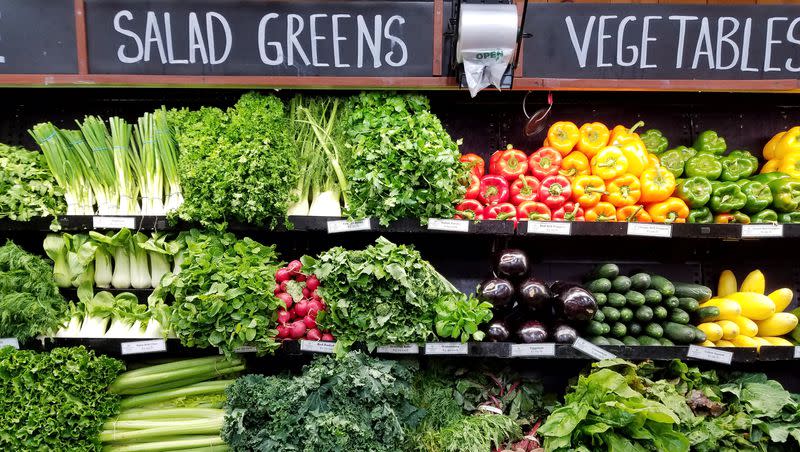11 ways to eat more vegetables

While vegetables are important to a healthy diet, only around 10% of adults eat enough fruits and vegetables, according to the CDC.
From broccoli to spinach to bell peppers, vegetables have different flavor profiles and health benefits. If you’re looking to increase the number of vegetables you eat, here are 11 tips on how to eat more vegetables.
Related
1. Start eating vegetables in the morning
Eating vegetables in the morning can be an easy way to start eating more of them. Some breakfast ideas to try that incorporate vegetables are smoothies, omelettes, egg scrambles, tofu scrambles, egg muffins, frittatas, potato and vegetable hashes, breakfast burritos and breakfast bowls.
2. Find a good salad recipe
Stumbling on a good salad recipe might take some time, but there might be a combination of vegetables you like. Eating a salad every night at the start of dinner can be a great way to incorporate more vegetables without thinking about it too much. A simple formula for a salad is a base like greens (or even roasted vegetables), something crunchy like carrots, something fatty like cheese or nuts, something sweet like tomatoes or apples and a dressing you like. You can add more vegetables, grains, proteins and other toppings to make the salad more filling.
3. Whip up a grain bowl
Having a routine grain bowl that you can have for lunch or dinner will help take the decision fatigue out of your meal planning. It’s also a way to use up what you have in the refrigerator. Start with a base like quinoa or rice and then add a combination of vegetables. You can do a mix of roasted and raw vegetables. Topping with a sauce can be a way to change up the flavor without doing too much.
4. Try veggie-topped pizzas
Whether it’s takeout pizza or pizza you made at home, you can add a couple vegetables to it in a jiffy. Chop up some spinach, broccoli, peppers, onions or whatever vegetables you and your family like, and then put on top on pizza before cooking. If you’re adding to an already cooked pizza, it might help to cook the vegetables before adding them to the pizza. You can also make the habit of adding a side salad alongside your pizza.
Related
5. Make a stir-fry
Making a stir-fry is a simple way of eating more vegetables, since the main part of stir-fry is the vegetables. If there’s a day where you don’t feel like eating salad because you want something warm instead, try a stir-fry.
6. Blend vegetables into smoothies
Drinking your vegetables is one way to consume more of them without thinking about it. Blending up some greens and other vegetables with your favorite fruits, like berries or pineapple, can double as breakfast or dessert. Use almond milk or Greek yogurt for an additional protein boost.
Related
7. Add a vegetable or two to pasta sauce
You can jazz up pasta sauce by blending vegetables into it. Say you have a standard jar of marinara sauce. You can blend zucchini or squash or carrots into it without detecting too much of a taste difference. If you’re making sauce on the stove with fresh tomatoes, toss in a couple other vegetables as you’re cooking the tomatoes.
8. Increase vegetables in soup
Soup can include a number of vegetables. If you’re making a chili, consider adding peppers and onions. If you’re making chicken noodle soup, consider adding cabbage, carrots, celery and onions. You can even add zucchini and broccoli. Say you’re making potato soup — you can add a couple heads of cauliflower and then blend it up. Think outside the box when it comes to what vegetables you can add.
9. Change out meat for vegetables
Do you like a piece of grilled steak? Substituting it for a grilled portobello mushroom or grilled cauliflower might be a hard sell, but it’s also something to consider trying. If you like a certain sauce or seasoning blend on your meat, try it on vegetables and make vegetables the star of your plate for a night.
10. Pair your favorite snack with a vegetable
Instead of thinking about giving up your favorite snack for a vegetable, think about pairing your favorite snack with a vegetable. If you like tortilla chips, make a vegetable-filled salsa and eat them together. Or if you like having a square of chocolate, consider eating it alongside some sliced cucumber.
11. Put vegetables in your desserts
Vegetables for dessert doesn’t need to be something overt, like adding kale and tomatoes on top of ice cream. You can add zucchini to chocolate cake batter or black beans into brownies or make a zucchini bread.
Why should I eat vegetables?
Eating vegetables has several benefits like blood sugar regulation, appetite regulation, reducing risk of heart disease and helping to lower blood pressure, according to Harvard Health Publishing.
Other benefits are maintaining gut health, weight regulation, lower risk of chronic disease, reduced risk for some types of cancer and better eye health, per University of Central Florida Health.
What are the best vegetables?
Here are 10 of the healthiest vegetables, according to Medical News Today.
Spinach.
Kale.
Broccoli.
Peas.
Sweet potatoes.
Beets.
Carrots.
Fermented vegetables.
Tomatoes.
Garlic.
Related
What are superfoods?
A superfood is a food that’s low in calories while also being nutrient dense, per the Cleveland Clinic. Superfoods are often high in antioxidants, minerals and vitamins.
What vegetables are superfoods?
Here are some vegetables that are also superfoods, according to the Cleveland Clinic.
Beets.
Arugula.
Beet greens.
Mustard greens.
Spinach.
Kale.
Dandelion greens.
Collard greens.
Swiss chard.
Bok choy.
Broccoli raab.
Garlic.

